Among the most recommended destinations in Vietnam, Hanoi capital city is always present on the list and maintains its good reputation as well as high ranking, which urges a full introduction to Hanoi Vietnam. While some tourists promptly comment they love the dynamic atmosphere around Hoan Kiem Lake, others appreciate the historical monuments preserved in the capital. Despite the economic development, Hanoi preserved the old-style nostalgic ambiance, traditional food, and long-lasting constructions. You don’t want to ignore the famous names of Hanoi Old Quarters, Ho Chi Minh Mausoleum, Temple of Literature, One-Pillar Pagoda, Thang Long ancient capital, and Tran Quoc Pagoda. Besides the traditional corners, the city owns the modern edges which promise not to disappoint the young travelers, groups of friends, couples, honeymooners, and even families with kids. It is a perfect venue for history buffs and foodies, who can learn Vietnamese history and try Hanoi Pho, plus the egg yolk coffee. Read on to obtain more information about Hanoi, the capital of Vietnam for more than a thousand years of history.
Overview of Hanoi Vietnam
Hanoi has been the capital city of The Socialist Republic of Vietnam since 1976 until now. It is the second-largest city in Vietnam, consisting of 12 urban districts, 1 district-level town, and 17 rural districts. Situated in the Red River Delta, Hanoi serves as the political and cultural center of the whole country. It is home to the venerable institutions of education and culture, namely the Vietnam National University, Vietnam National Museum of Fine Arts, and My Dinh National Stadium. Also, it hosts a UNESCO World Heritage Site – The Central Sector of Thang Long Imperial Citadel (erected in 1011). Among its achievements, Hanoi won the “City for Peace” title granted by UNESCO on 16 July 1999. The title reflected Hanoi’s contributions to the fight for peace, efforts to enhance quality in the community, environment protection, culture-education promotion, and attention to young generations. Various international events took place in Hanoi, such as APEC Vietnam 2006, 2003 Southeast Asian Games, 2009 Asian Indoor Games, 2021 Southeast Asian Games, etc. Scattered through Hanoi are various historical landmarks to see. Merely the Hanoi Old Quarters preserve the age-old houses, alleys filled with street food stalls, and friendly Hanoians will keep entertaining your days and nights. Furthermore, Hanoi Food of Pho and egg yolk coffee are among the best things to say about this city that one should always savor. First-time guests can also enjoy Hanoi Water Puppet Tours in Thang Long Theater for a glimpse of the local traditional form of entertainment.
Geographical Location
Hanoi is in the Red River Delta of Vietnam, approximately 90km from the coast. It is a landlocked municipality in northern Vietnam, consisting of three types of terrain: the delta, the midland, and the mountainous areas. Generally, the terrain is perceptibly lower from north to south and from west to east. Its average height is ranging from 5 to 20m above sea level. The northern and western parts of the city host the hills and mountains, while Ba Vi is the highest peak at 1,218m. Geographically, Hanoi is bordered by Thai Nguyen and Vinh Phuc in the north, Ha Nam and Hoa Binh in the south, Bac Giang, Bac Ninh, and Hung Yen in the east, and Hoa Binh and Phu Tho in the west. Hanoi has been a popular stopover for many tourists who are going on a grand tour to Ha Giang, Sapa, Halong Bay, Ninh Binh, etc. Also, Noi Bai International Airport serves as a critical terminal for both domestic and international visitors.
Weather Characteristics
Hanoi experiences the tropical monsoon climate and has four distinct seasons as follows:
- Summer: from May to August, featuring the hot and humid weather. It might experience rainfall and dry days.
- Fall: from September to November, when the temperature decreases, it becomes warm and mild.
- Winter: from December to January, when the city gets cool and dry by the northeast monsoon. The sunshine might be prolonged during the days.
- Spring: from February to April, characterized by the cloudy and foggy conditions, with the little sunshine due to the strong influence of the southeast monsoon giving moisture from the sea to the inland. Walking for hours past Hoan Kiem Lake to Hanoi Old Quarter at this time becomes a chilly joy as you won’t sweat.
The average temperature in Hanoi is 23.6 Celsius degrees, with a relative humidity of over 80%. The hottest month of the year could be June. Sometimes, the city might experience snow in winter occurred on the Ba Vi Mountain range, in which the temperature might decrease to 0 Celsius degree. In 2016, it recorded snow on the Ba Vi peak.
When to visit Hanoi Vietnam
Answers about the best time to visit Hanoi might vary due to each tourist’s preferences about the prices, lines of tourists, what the climate is like, transport and accommodation availability, etc. In general, the peak time in Hanoi Tours runs from February to April, especially during the Lunar New Year Festival or Tet, when the transport and hotel charges are highly booked and increased. To save your seat, it’s always advised to book things in advance. Do NOT wait until you arrive at the capital city and then search for a place to rest. Therefore, if you want to join and see how the Hanoians welcome the New Year and celebrate the traditional Tet, let’s go there on Tet time. It’s when the streets are lined with stalls selling Tet decorations, treats, and gifts. Right in the Temple of Literature, people will be pleased to enjoy the calligraphy arts. Also, the spring weather is warm and sunny, which is perfect for outdoor sightseeing and discovery.
What’s more, Hanoi is famous for its beautiful autumn time when the yellow leaves fill the roads, and the flowers perfume the streets. The blue sky, bright sun, and calm wind also add pleasure to your trips. In autumn, different flower species start blooming. That explains why some individuals say the best time to travel to Hanoi is in autumn, from September to November.
Tips when you are in Hanoi
Per the weather nature of each season, keep yourself updated on the weather forecast on the days coming to your departure. This helps you create a reasonable travel plan to arrive at the capital city and avoid either the scorching sun or the heavy rain. The city remains both ancient and modern to keep appealing to guests who are always recommended to spend time wandering the Old Quarter and stop by the landmarks. When it comes to dining time, make sure to eat Pho, Bun Cha, Bun Dau Mam Tom, Banh Tom, etc., and egg yolk coffee.
Hanoi History and Development
This post talks about the history of Hanoi from the time under Independent Vietnam (1010 and onwards) to the modern Hanoi.
Thang Long, Dong Do, Dong Quan, and Dong Kinh
In 1010, Emperor Ly Thai To moved the capital of Dai Viet to Dai La Citadel. The first emperor of the Ly dynasty renamed the site “Thang Long” (Soaring Dragon) as per his dream about a dragon ascending the Red River. Thang Long served as the capital of Dai Viet till 1397. Later, “Tay Do” (the Western Capital) was made the capital city, which made Thang Long “Dong Do” (the Eastern Capital). In 1408, under the attack of the Chinese Ming dynasty, Vietnam was occupied, and Dong Do was renamed Dongguan (meaning Eastern Gateway) or Dong Quan (in Sino-Vietnamese). In 1428, the Chinese were defeated by the Vietnamese army led by Le Loi, who later became the founder of the Le dynasty and renamed “Dong Quan” to “Dong Kinh” (Eastern Capital). When the Tay Son dynasty was concluded, the capital was named Bac Thanh (Northern Citadel).
At the time of the Nguyen Dynasty and French colonial rule
In 1802, the Nguyen dynasty was founded by Emperor Gia Long, who moved the capital to Hue City, leaving Thang Long no longer the capital. In 1831, The Nguyen Emperor Minh Mang renamed Thang Long to Hanoi (meaning Between Rivers). In 1873, Hanoi became occupied by the French and was put under colonial rule for the next 10 years. After 1887, Hanoi functioned as the capital of French Indochina.
During World War II and Vietnam War
In 1940, Hanoi Vietnam was occupied by the Imperial Japanese. In 1945, it was liberated and became the seat of the Viet Minh government after the proclamation of independent Ho Chi Minh City. Nonetheless, in 1946, Hanoi was reoccupied by the return of the French. After 09 years of war between the French army and Viet Minh forces, the North of Vietnam won its independence and Hanoi become the capital city of northern Vietnam in 1954. In the same year, the French army withdrew under the terms of the 1954 Geneva Conference.
During the Vietnam War (from 1955 to 1975), the transportation facility namely the bridges and railways of Hanoi was destroyed by bombing by the U.S. Seventh Air Force and the Republic of Vietnam Air Force. Several sites were later repaired or reconstructed. By the end of the war, North and South Vietnam were reunified. On 2 July 1976, Hanoi became the capital of the reunified Vietnam.
Modern Hanoi Vietnam
With the approval of the “Doi Moi” economic policy in 1986, the Communist Party and governments aimed to attract international investment in Hanoi’s urban construction projects. Around 10 years later, people witnessed the rapid urban development and cost increase in central Hanoi. After the 1997 Asian financial crisis, Hanoi faced a short period of economic stagnation. Then, it resumed its rapid economic development. There was even the establishment of the Hanoi Capital Region (Vung Thu Do Hanoi) which was a metropolitan area including Hanoi and six surrounding provinces. In recent years, the capital has experienced a construction boom with various skyscrapers and modern malls which have dramatically changed the cityscape. It has also formed an innovative skyline outside of the old quarters. In 2015, Hanoi was ranked 39th in the list of cities with the most skyscrapers over 100m in the world. Its two tallest sites are Hanoi Landmark 72 Towers (336m in height, the second tallest in Vietnam) and Hanoi Lotte Center (272m in height, the third tallest in Vietnam); both are after Ho Chi Minh City’s Landmark 81 (461,2m). The old-and-modern corners of Hanoi keep attracting domestic and international tourists who are pleased to explore the city’s highlights of attractions, food, culture, and people. The tropical monsoon climate in Hanoi is favorable too, in general.
Introduction to Hanoi’s Means of Transport
There are ways to get to Hanoi capital city, ranging from airlines to trains and coaches. Noi Bai International Airport has been witnessing numerous domestic and international flights getting to Hanoi on a daily basis. Hanoi also serves as a stopover before you get to other nearby provinces. If you’re not far from Hanoi, then choose the coaches, public bus, or motorbikes to get there. It is no limitation on the means of transportation to this famous city.
There are also ways to get around Hanoi. Upon your arrival, you can hire a motorbike (with or without a driver) to roam around the Old Quarter and neighboring landmarks. Another channel is to call a motorbike taxi or use the Grab service. If you’re going in a small group, opt for the taxi service; though the cost is a bit high, it’s safe and fast to carry you to any place in Hanoi. For a quick tour of the Old Quarter, get on a cyclo, and enjoy the view. You are likely to find many cyclos gathering around Hoan Kiem Lake. A new type of transport is the environment-friendly electric car for a complete tour of the ancient and modern Hanoi.
Introduction to Hanoi’s Most Famous Attractions
Hanoi Old Quarter
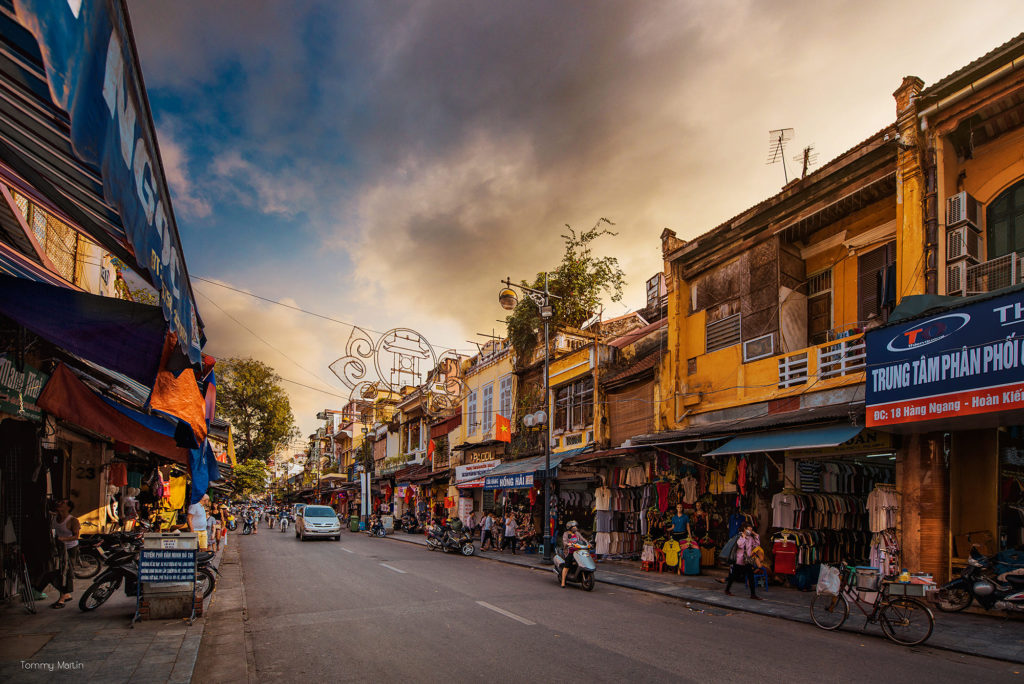
Located nearby Hoan Kiem Lake, Hanoi Old Quarter or Hanoi 36 Streets is the mistakable landmark of Hanoi that one should always enjoy a walk. Roaming around the old alleys and ancient-looking houses provides a good back-in-time adventure, which is precious and could not be found elsewhere. Remaining old, peaceful, and nostalgic, the Old Quarter is packed with indigenous Hanoians’ houses, street vendor stalls, authentic street names, and inherent cultural values. Each street is specialized in selling certain items, for example, Hang Duong is known for “O Mai” (salt or sugar dry apricot) while Hang Ga is famous for printing wedding cards. Houses in the Old Quarter mostly preserve their 20th-century architecture with tiled roofs and little business shops on the façade. Generations of the Hanoians live in the houses and keep their lifestyle and culture. It might take even a day to explore Hanoi Old Quarter from morning to night. Especially at night, the areas become dynamic and lively with many expats who come for the Hanoi street food, pubs, bars, and mingling opportunities. Check out Ta Hien street!
Hoan Kiem Lake
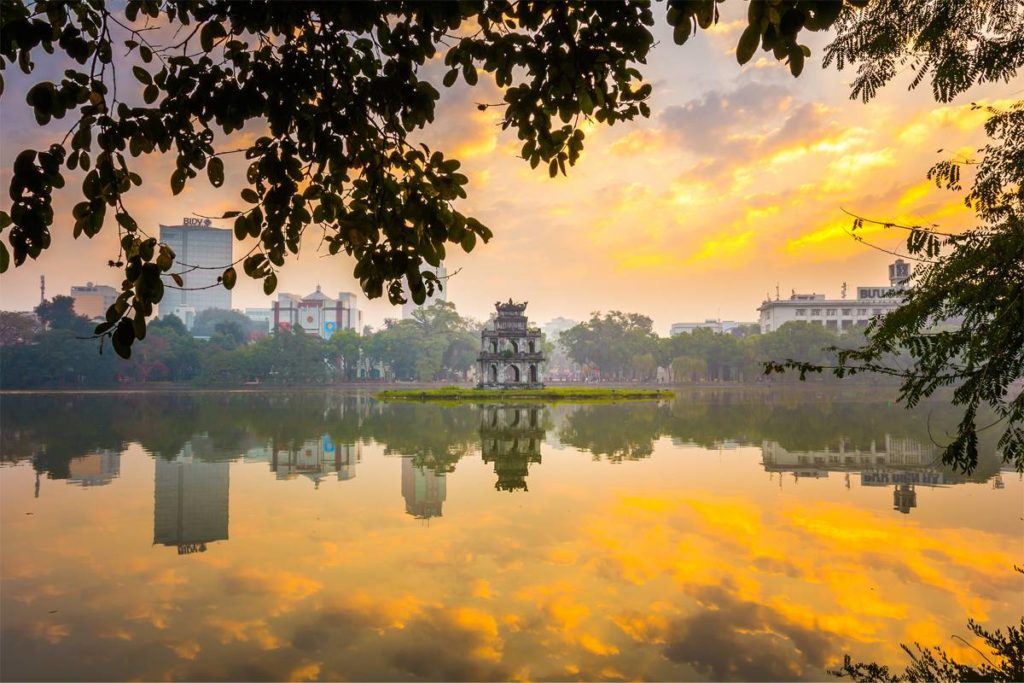
Hoan Kiem Lake is a favorite hangout venue for both Hanoians and guests who can mingle well, communicate, and enjoy Hanoi food. Regarding the name The Lake of the Restored Sword, it was linked to a local legend that Emperor “Le Thai To” gave back a magical sword to the Turtle God after he defeated the enemy. To show gratitude to the Turtle God, the emperor named the lake and protected it. As time passes, the legend about the lake has been imprinted on the Vietnamese’s beliefs and everybody is aware of their responsibility to honor the lake, in which the Turtle God might live. At present, Hoan Kiem Lake is an ideal spot to get started on your Hanoi day tour towards the Old Quarters including the famous streets like Luong Van Can, Dinh Tien Hoang, Hang Dao, Hang Bai, Ba Trieu, etc. The not-to-miss attractions nearby the lake are the Turtle Tower, Ngoc Son Temple, Ba Kieu Temple, and The Huc Bridge. Whether it’s early morning or late night, the lake has its distinctive charm attracting locals and tourists. People enjoy morning exercise, walking, sightseeing, visiting the historical sites, eating, and shopping around the lake corners. So, if you want to feel the young energy of Hanoians, get to this hangout lake.
Temple of Literature
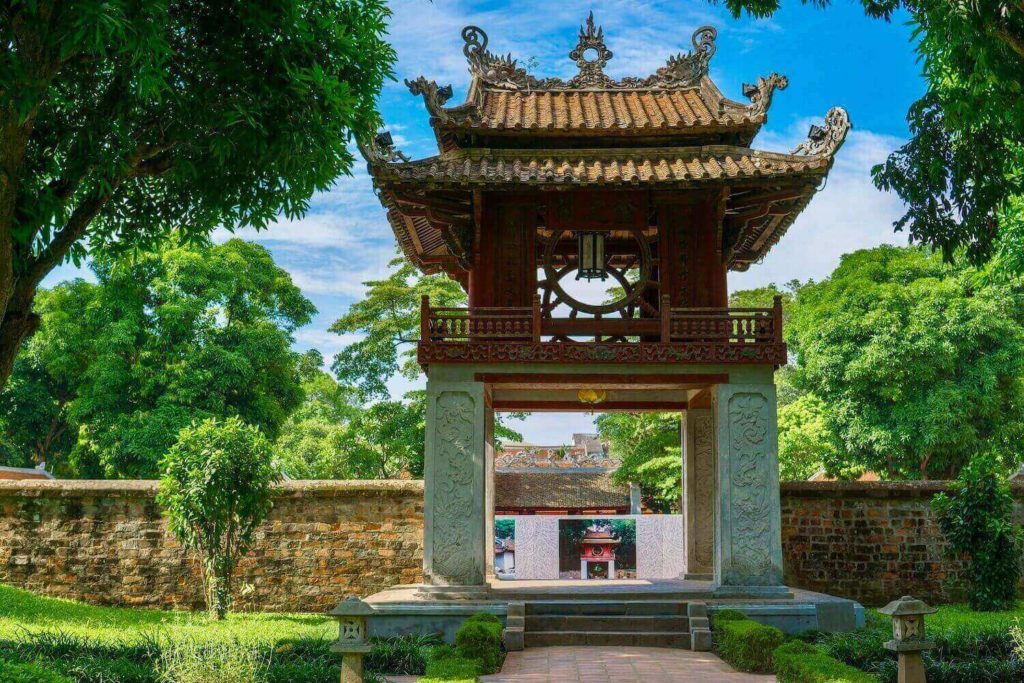
Temple of Literature (Van Mieu – Quoc Tu Giam) was the first university complex in Vietnam. Van Mieu was erected at the time of Emperor Ly Thanh Tong around the year 1070 to worship Confucius, sages, and scholars (Chu Cong, Khong Tu, and Tu Phoi). Meanwhile, the Imperial Academy (Quoc Tu Giam) was constructed as an additional building in 1076 under the reign of Emperor Ly Nhan Tong. The place stores many pavilions, statues, halls, and stelae of doctors reflecting the time when ceremonies and exams of the Dai Viet took place. Nowadays, this destination is frequently visited by local students coming to pray for good luck on their exams. The construction preserves its old look and Nguyen royal architecture, which are worth a discovery. What’s more, the visit lets you witness a gallery of students’ uniforms during the Imperial Academy period. That was what the students of the old-time dressed while studying in the 15th century and in subsequent decades. The courtyards preserve the ancient layouts for your sightseeing.
St. Joseph’s Cathedral Hanoi
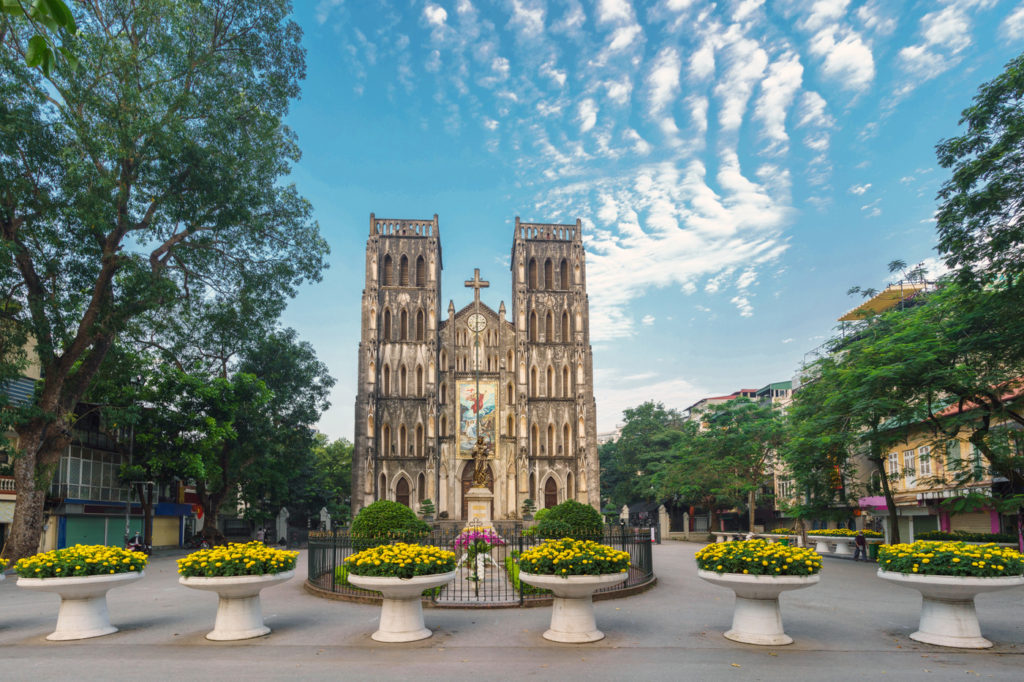
St. Joseph’s Cathedral (Nha Tho Lon Hanoi) owns the late 19th-century architecture Neo-Gothic style, which looks ancient and photogenic. The cathedral was named after Joseph, the patron saint of Vietnam. Historically, its construction began in 1886 by the French colonial government and served as the oldest church in Hanoi. It is located west of Hoan Kiem Lake, making up the attractive clusters of attractions to see. Per exterior look, the stone slabs and brick provide a concrete look. The façade features two towers in a square shape. Per the interior, the windows have stained glass produced in France before being taken to Hanoi. The rib-vaulted ceilings inspire the medieval European style. You will also see a statue of the Virgin Mary in a palanquin. What’s more, at the end of the church street is a market of boutiques and silks.
Imperial Citadel of Thang Long
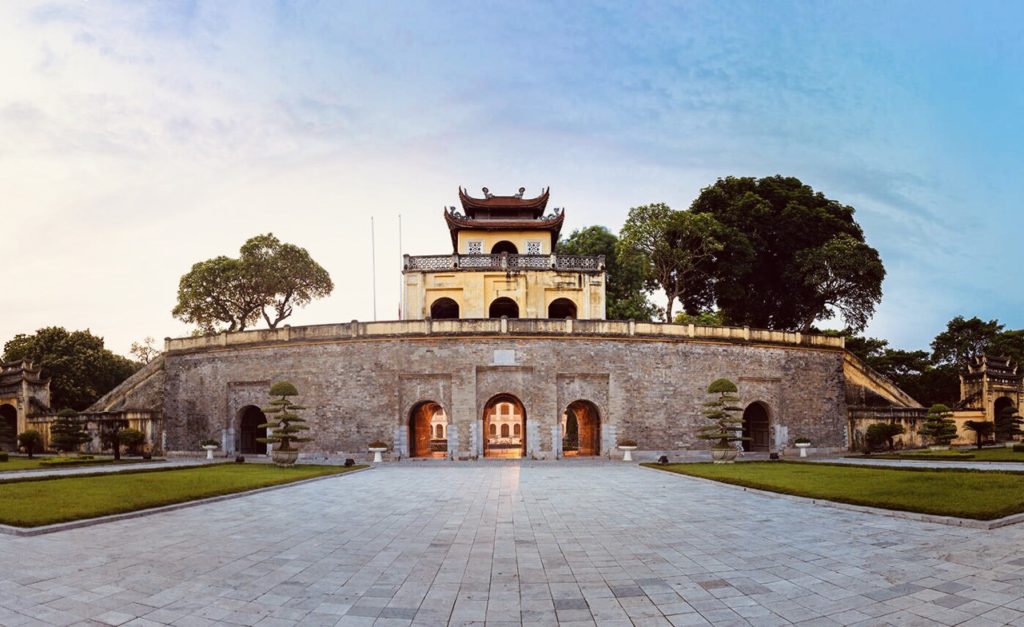
Imperial Citadel of Thang Long includes a complex of ancient imperial buildings situated in the center of the Hanoi capital. The Citadel was first constructed in 1011 at the time of Emperor Ly Thai To. It was later expanded by the subsequent dynasties of Tran, Le, and Nguyen. Thang Long Imperial Citadel served as the capital of the Vietnamese court till 1810 when the Nguyen dynasty moved the capital to Hue. Going through the ups and downs of history, the Central Sector of the Imperial Citadel of Thang Long was recognized as a UNESCO World Heritage Site on July 31, 2010. The heritage should always be considered one of the best attractions to see in Hanoi.
Ba Dinh Square – The President Ho Chi Minh Mausoleum
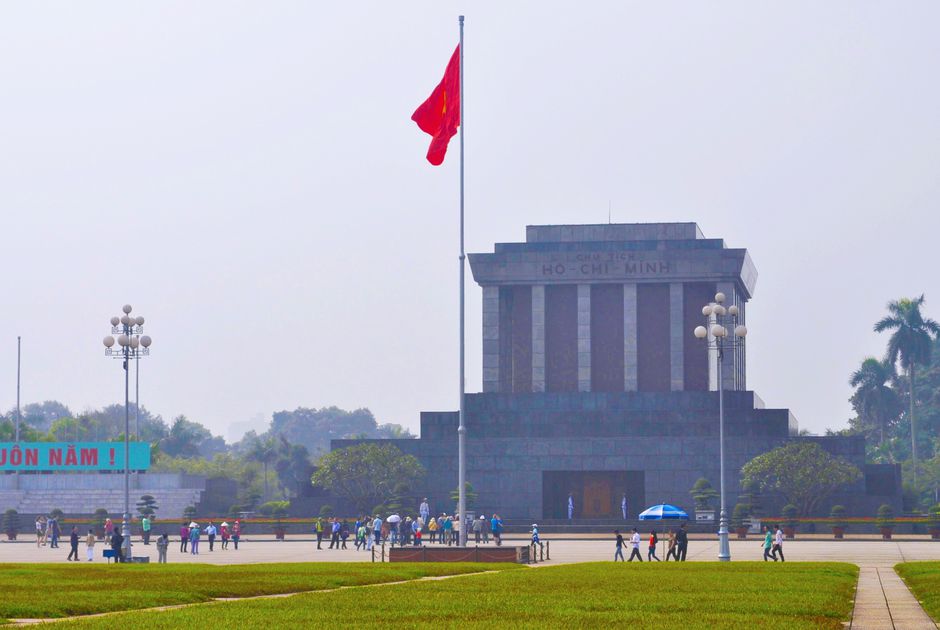
The spacious Ba Dinh Square holds significant historical value to Vietnam. It was where President Ho Chi Minh (Uncle Ho) read the Declaration of Independence to establish the Democratic Republic of Vietnam on 2 September 1945. The square has been witnessing various events and the solemn parade of the country. It has a width of 100m and a length of 320m, which is perfect for celebrating important festivals. It is also ideal for hangouts, sightseeing tours, and walking to mingle with other participants. Upon your arrival at Ba Dinh, make it a must to visit The President Ho Chi Minh Mausoleum. Not only does the mausoleum have solid and extraordinary architecture, but it also preserves the precious spirituality of Uncle Ho, the “father of the nation,” his love for independence and freedom of Vietnam. The resting place of Uncle Ho is open to the public. If arriving in the early morning, you can expect to view the parade in the plaza in front of the mausoleum. Know that the surrounding gardens feature around 250 different plant and flower species from various regions of Vietnam, which shows the whole nation’s love for President Ho Chi Minh.
One-Pillar Pagoda

The name of the pagoda can even tell its unique characteristics as the pagoda was built over a single pillar. Constructed in 1049 under the reign of Emperor Ly Thai Tong and taking more than 50 years to complete in 1105, the One-Pillar Pagoda preserves the “long life and happiness” meanings. Going through several times of restorations, the present pagoda has the design of architect Nguyen Ba Lang in 1955, which was inspired by the Nguyen dynasty’s architecture. It is made of wood on a single stone pillar of 1.25m in diameter and 4m high. The design resembles a lotus blossom, which is a symbol of purity in Buddhism. It serves as a historical Buddhist site in the center of Ba Dinh district and is an iconic pagoda of Vietnam. Any tour in Hanoi won’t be complete without a picture of this must-see.
Long Bien Bridge
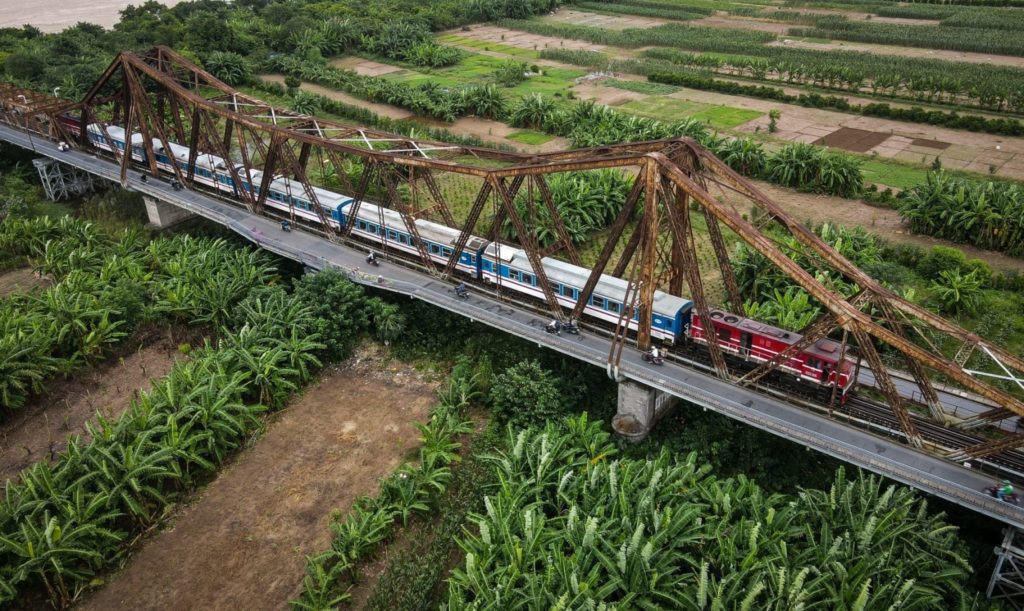
Long Bien was the first steel bridge across the Red River. It was constructed in the period between 1898 to 1902 by the French architects Dayde & Pille of Paris. Opened in 1903, the construction connects two districts of Hoan Kiem and Long Bien. Its original name was “Paul Doumer Bridge” before the independence of northern Vietnam in 1954. Its measure was 2.4km in length, which made it one of the longest bridges in Asia at that time. Due to its important position as the only bridge connecting Hanoi and Hai Phong port, the bridge was heavily bombed during Vietnam War and subsequent wars. Going through the harsh wartime, only half of the historical Long Bien Bridge remains intact, and the bridge plays a meaningful role in Hanoi’s self-image. Long Bien bridge has been mentioned in Vietnamese poems and songs, and its black-and-white photographs are the precious properties of the country. A visit to this historical site is a unique activity of Hanoi Tours. The sunset over the Red River from Long Bien Bridge looks picturesque.
New Vietnam Military History Museum
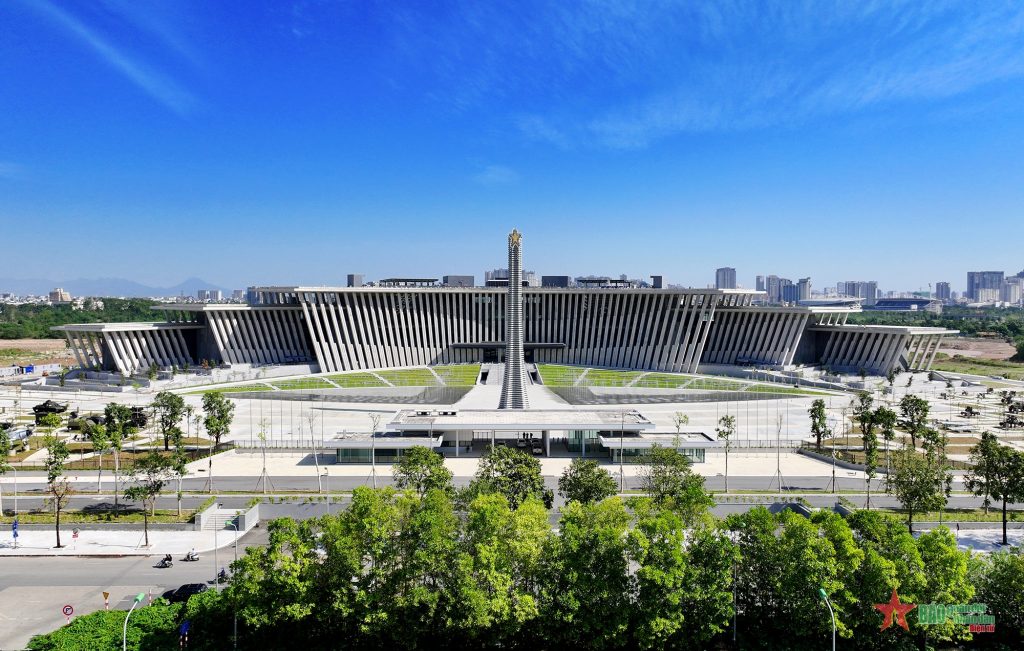
The new Vietnam Military History Museum, opening on November 1, 2024, at Km 6+500, Thang Long Avenue, Tay Mo, Dai Mo, Nam Tu Liem District, Hanoi, is a modern and expansive institution dedicated to showcasing Vietnam’s rich military history. Covering an impressive 386,600 square meters, the museum houses over 150,000 artifacts, including four national treasures. Its modern design creates a unique, interactive environment where visitors can engage with the nation’s military heritage through advanced technology, such as 3D mapping models, touchscreen information panels, and multimedia displays. The museum highlights key moments in Vietnam’s military history, from the early days of nation-building to its struggles for independence and defense against French and American forces.
A major highlight is the iconic MiG-21 “Silver Swallow” aircraft (No. 4324), suspended dramatically from the ceiling, representing the bravery of Vietnamese pilots during the Vietnam War. Outside the museum, visitors can explore military vehicles and weapons used by both Vietnamese and foreign forces, including tanks, artillery, and aircraft. The Victory Tower, standing 45 meters tall, dominates the museum’s exterior, symbolizing Vietnam’s enduring spirit and triumphs in war.
The exhibition is divided into six thematic sections, allowing visitors to journey through Vietnam’s military history chronologically, from the early struggles for independence to modern-day national defense. The museum offers a deeply immersive and educational experience, blending historical artifacts with cutting-edge technology, making it a must-visit destination for those seeking to understand Vietnam’s military legacy. Free admission is available until the end of December 2024, making it an excellent opportunity for both locals and tourists to explore this important cultural institution.
Read full travel guide to the new Vietnam Military History Museum here!
Hanoi Capital City is the normally the destination for arriving or departing on the vacation to Vietnam!
Introduction to Hanoi’s Best Accommodations
Budget Hotels in Hanoi Old Quarter
It’s a good recommendation to sleep in Hanoi Old Quarter while you’re in Hanoi because it offers easy and quick access to the main attractions. Nonetheless, if you want to sleep early, avoid choosing the hotels near Ta Hien Street as this place might get noisy and chaotic until midnight. It has bars and pubs to unwind and chill out. Here are some good names to get started with: Oriental Suites Hotel & Spa which is just a few kilometers from Hoan Kiem Lake; Hanoi Backpackers Hostel is a cheap address for backpackers within around 5 USD per night; Little Charm Hanoi Hostel is known for good service at a reasonable price, complimentary breakfast, and free beer hour.
Sofitel Legend Metropole Hanoi
For a sense of luxury and for a query about the most luxurious hotel in Hanoi, then you should book a room at the Sofitel Legend Metropole Hanoi. The list of the best hotels in Hanoi cannot miss this brand name. Not only does this 5-star construction look stunning, but it is also a historical landmark since 1901. The exterior of the splendid hotel surely convinces you that it’s worth every dollar and cent, with no doubt about the interior structure and ultimate comfort. Located nearby Hanoi Old Quarter, the ritzy property offers easy access to pubs, bars, restaurants, and shops for your full entertainment. The hotel itself also pleases guests with spa service, swimming pool, fitness class, and classic French-style rooms. Have a night there and enjoy the life of roses.
Hanoi Marvelous Hotel & Spa
Designed with the old-world charm, Hanoi Marvelous Hotel & Spa features elegant décor, exceptional chandeliers, hardwood floors, and lavish fabrics. It’s where you lay your head in a peaceful and beautiful room. The staff is also famous for the friendly nature that makes guests feel homelike and comfortable. If you’re a kind of nostalgic traveler who enjoys the ancient design in each detail, this hotel is the right place to rest. The spa treatment is so relaxing that helps pamper your feet after a long walking tour. This address is located right near the Hoan Kiem Lake, which means you can easily walk toward the major tourist sites nearby.
Lotte Hotel Hanoi
Lotte Hotel Hanoi is located in the upper part of the amazing 65th floor Lotte Center. This proudly represents an upscale standard of the 5-star hotel that people should always experience once. The site is ultra-chic and luxurious and provides a magnificent city view of Hanoi from the rooftop bar. Each room is spacious and ultimately comfortable with state-of-the-art amenities and splendid décor. You have everything you need for a cozy and super-duper luxurious stay. Anytime you want, enjoy the indoor and outdoor pools, sauna facility, fitness room, onsite spa, ritzy restaurant, etc., which guarantee your pleasure and comfort. Other new services include the Pharaoh’s Bar & Supper for gorgeous panoramic Hanoi city night views and live music performances. Each sector of the hotel provides countless Instagram-worthy corners.
JM Marvel Hotel & Spa
Highlights of JM Marvel Hotel & Spa are the large and stylish rooms designed in a black-and-white theme. The helpful staff is also a great score on the site. They’re ready to assist when you want to book a tour, call a taxi, or show you the way to a landmark. Most guests agree to feel homelike when staying in this friendly accommodation. The mysterious theme of the hotel provides a photogenic and artistic background for photography. This haven of relaxation treats you well with excellent services at the 4-star level. Make sure you enjoy the restaurant, rooftop bar & coffee, and panoramic city view of Hanoi from this spot. It offers quick access to the Thang Long Water Puppet Theater within nearly 1km, the St. Joseph’s Cathedral via the 12-minute walk and Dong Xuan Market for 1,2km.
Introduction to Hanoi Food to Eat
Undoubtedly, Hanoi owns one of the most diverse and distinctive cuisines in Asia and the world. It’s famous for its colorful flavors, crunchy tastes, and fresh herbs, which all establish an unbeatable harmony in the mouth. If you ask for the best dishes to eat in Hanoi, here are the top 10. While you can find them across the country (and even in some parts of the world), it’s believed that the best versions of these dishes are still only found in Hanoi – the culinary capital of Vietnam.
Pho Bo (beef noodle soup)
Foodies keep posting their compliments about Hanoi Pho – a culinary pride of Vietnam, which moves beyond the nation’s borders to reach the international context. Vietnamese Pho is the classic signature food that you MUST always eat in the cradle city. A bowl of Hanoi Pho should include the steaming beef broth filled with rice noodles, slices of beef, and some kinds of fresh herbs. Another good version might use chicken as an addition to the bowl. Thanks to the wide popularity and immense love from foodies, it’s easy to find Pho across cities in Vietnam and even in overseas corners, but the original one in Hanoi is always the best to savor and evaluate. Hanoi has several outstanding brands for Pho like Pho Bat Dan, Pho Thin, Pho Ly Quoc Su, etc., which you can easily track down the route and get there. Expect to see a long line of patrons. Note that you can opt for what cuts of meat you like in our Pho bowl.
Bun Cha (rice vermicelli with grilled pork)
As good as its reputation, “Bun Cha” won the interest of President Obama as he enjoyed the food when he first came to Hanoi. A bowl of “Bun Cha” consists of rice vermicelli, herbs, grilled fatty pork, and dipping sauce. The soul of the food lies in the fish sauce mixed with chili, sugar, garlic, and lime juice. Alongside the bowl of pork soup and fish sauce, you will find plates of rice vermicelli and fresh herbs. This food offers an attractive look and aromantic smell that urge people to enjoy even the last drops. There are many food stalls serving this kind of noodle soup in Hanoi, and the famous names are Bun Cha Huong Lien and Bun Cha Ta Hanoi. Order a bowl and see why the other foodies and famous characters evaluated this food so much. You might even miss the taste upon home return.
Cha Ca (turmeric fish sausage)
For more than 130 years since its first introduction, Cha Ca La Vong has been a must to eat in Hanoi. There is even a local street dedicated to this food, namely the Cha Ca street. The grilled fish sausage with turmeric and dill is the perfect addition to some kinds of noodle soups. Solely eating the fish sausage is enjoyable. People might also wrap the sausage into the rice paper, and then dip the rolls into the well-spiced fish sauce, providing an unforgettable taste. Originally, the fish is made from “Hemibagrus” (a species of catfish). However, this kind of fish becomes rare, so people turn to using snakehead fish instead. To make it, the fish is deboned, cut into pieces, and seasoned with turmeric and some spices. Then, people use banana leaves to wrap the seasoned fish and grill it over a charcoal fire. When served, the fish is cooked again and added with dill and green onions. It can also be served with plates of rice vermicelli, chili, cilantro, peanut, and a bowl of dipping fish sauce. They compliment each other just perfectly!
Banh Mi (Vietnamese sandwiches)
The Vietnamese sandwich is distinctive, featuring a mixture of wheat and rice flours covered by a thin crispy crust. Added to the sandwich is a series of fillings which could be pork, pate, omelet, sausage, cucumber, carrot, coriander, radish, and more depending on the shops. Each bite of Banh Mi provides a wealth of textures and flavors. It can be spicy, sweet, salty, and aromatic due to your preferences. You can ask the vendors to either add chilis to the complex or not. Otherwise, if you don’t like coriander, just remove it. A complete Vietnamese sandwich is flexible with different fillings, and foodies can surely customize it. The crunchy crust plus the delicious fillings can convince even the most fastidious foodies in the world. If you’re feeling a bit adventurous or wanting to try something new, just tell the vendors to give you a mix of everything they have on hand. The special version might be good.
Banh Cuon (rolled rice flour pancake)
Banh Cuon is a favorite breakfast choice for anybody in Hanoi. The rolled rice flour cakes can be served hot and in a quick way, which stimulates every gourmet to order dishes. The hot rolls including minced pork and mushroom inside will be dotted with shallot and soaked in the well-spiced fish sauce. It creates an attractive look, and the taste is surely amazing. Another yummy version of the rolled cakes in Hanoi is “Pho Cuon” (rice noodle roll) consisting of beef and green herbs, which is worth savoring too. Basically, “Pho Cuon” has the ingredients of Pho but with no broth. The beef and herbs will be wrapped into a wide rice noodle for making rolls. To enjoy it, you just dip the rolls into a bowl of sweet fish sauce.
Xoi Xeo (sweet sticky rice with mug bean paste)
This is a traditional food of Hanoi and plays an important role in Hanoians’ childhood memory. It is a common breakfast that almost every Hanoi’s kids enjoy over decades. The sweet sticky rice has green mung bean paste, soy sauce, and fried shallots in common. You can ask for a variety of add-ins like boiled chicken, pate, sausage, marinated pork belly, or fermented hard-boiled eggs. In Hanoi, several restaurants might serve “Xoi Xeo” as dessert; it’s sweet and yummy, which leaves a memorable taste. On any cold night in Hanoi, a box of hot sweet sticky rice can even warm and cheer up your stomach.
Nem Cua Be (crab spring rolls)
If the Mekong Delta region has ‘Cha Gio,” then Hanoi owns “Nem Cua Be.” Both refer to the crunchy deep-fried spring rolls yet vary due to the filling. Hanoi’s spring rolls include the ingredients of minced crab meat, pork, shrimp, mushroom, fried onion, pepper, and different types of seasoning. A plate of crab spring rolls looks eye-catching with the yellow deep-fried look. More amazingly, the nutrient fillings once dipped into the fish sauce provide the appetizing flavor that none can forget. Due to its famous deliciousness, “Nem Cua Be” could be found in the big cities across Vietnam, not only in Hanoi.
Bun Dau Mam Tom (noodle and tofu with shrimp paste)
The food name reflects that it includes three major components, which are noodles, tofu, and shrimp paste. First, the rice noodles are cut into bite-sized pieces. Second, the squares of tofu are deep-fried to be golden brown and have a crispy taste. Third, a bowl of fermented shrimp paste makes up the signature of the food. The paste might be extremely smelly to some first-time gourmets; if it’s the case, people can ask for an alternative: fish sauce. The overpowering smell of the shrimp paste sets the tray of “Bun Dau Mam Tom” apart from any other dishes served on a tray. The more often you eat the food, perhaps, the more addicted you become to the shrimp paste. Some people might confidently conclude that they love “Mam Tom.” The lack of shrimp paste won’t fully establish the true flavor of the food.
Egg Coffee (Café Giang)
The egg coffee was first invented in 1946 by Mr. Giang Nguyen. At that time, due to the shortage of milk in Hanoi, Mr. Giang creatively added whisked eggs to the coffee, which resulted in the original eggy version. As time passes, the recipe has been upgraded with the add-ins of sugar, condensed milk, and even cheese. It tastes great nowadays and becomes a must-try in Hanoi. The egg coffee tastes rich and creamy, which makes it like a dessert. You can choose to enjoy this “dessert” in the original Café Giang or take it easy to grab a cup of Egg Coffee at numerous coffee shops all over the capital city.
Bun Thang (rice vermicelli with chicken, pork, egg, and over 20 ingredients)
Bun Thang is another great noodle soup in Hanoi. Its major ingredients include chicken, pork, and egg served with rice vermicelli in a bowl of broth. The Hanoians often have it for lunch. Note that the broth is made up of over 20 ingredients from the fried shrimp and squid to various herbs and greens, etc. It is a long list of spices used to create the taste, but the most common ones are fish sauce, sugar, shrimp paste, and vinegar. A bowl of “Bun Thang Hanoi” looks so attractive and nutrient that you might want to slurp it right away once served hot. The sweet broth from the pork bone and chicken combined with eye-catching toppings make everybody interested in eating this iconic Hanoi food. There is an online recipe to cook “Bun Thang” at home, and my Vietnamese families enjoy it. Try it out, and then say how it is!
Introduction to Hanoi Food Tours
Being the political capital as well as the culinary capital of Vietnam, Hanoi has all the potential needed for a wonderful street food tour. Some packages might include the Water Puppet Show, a visit to the local markets, a hands-on cooking class, etc. Therefore, it’s up to you to sort out the packages that best meet your preference. Or you can simply like a Hanoi Street Food Tour around the Old Quarter, which is filled with numerous excellent food stalls. This way, the culture, the food, and the gastronomy of the destination are present well that you experience the real-time taste and interactions with Hanoians. You can choose to join a food tour with other small groups or privately enjoy it with an accompanying tour guide. What’s more, there are food tours on motorbikes roaming around Hanoi. If you love cooking, it’s fantastic to enjoy the hands-on Vietnamese cooking classes, get the recipe, practice, and enjoy the result. If you’re vegetarian, there is even a Hanoi Vegan Food Tour to enjoy. Thanks to the increasing interest, more and more culinary packages have been designed in Hanoi, which expands your choices. With just a simple Google search, you will come up with dozens of available packages. Choose to either include a cooking class in your food tour! The on-foot tour will also let you discover the eating etiquette of Hanoians, their market atmosphere, local ingredients, etc. The English-speaking tour guide helps direct you to reliable street vendors to eat.
Hanoi Future Orientation
Over decades, Hanoi Vietnam has been establishing its position on the tourism maps of Vietnam and in the world. Going through the harsh damage by COVID-19 since 2020, Hanoi Tourism is starting to adapt to the new-normal state and regain its growth momentum. Its orientation is to develop truly sustainable tourism. The city has plans to attract more domestic and overseas tourists toward 2025 by implementing strategic breakthroughs. It will form the key tourism clusters according to regions: 1) central Hanoi tourism cluster (dedicated to the cultural, heritage, and culinary tourism); 2) urban tourism cluster (develop MICE tours, sports, and entertainment); 3) suburban tourism cluster (focus on resorts, ecotourism, countryside landscape, and nature-friendly experiences). Besides, the city promotes the application of Information Technology and the digital transformation of the Hanoi tourism industry. This helps advertise the ancient and modern images of Hanoi to the world. Along with that, tourist agencies are stimulated to design attractive itineraries to enhance the tourists’ experiences and urge them to spend, instead of merely giving discounts. It’s aiming to popularize the name of Hanoi so that whenever tourists think about cultural and heritage tourism, they will travel to Hanoi. The Hanoi architecture, festivals, lifestyle, cuisine, etc., should be unique and appealing enough to win back the visitors’ interest and inspire them to visit the city repeatedly.

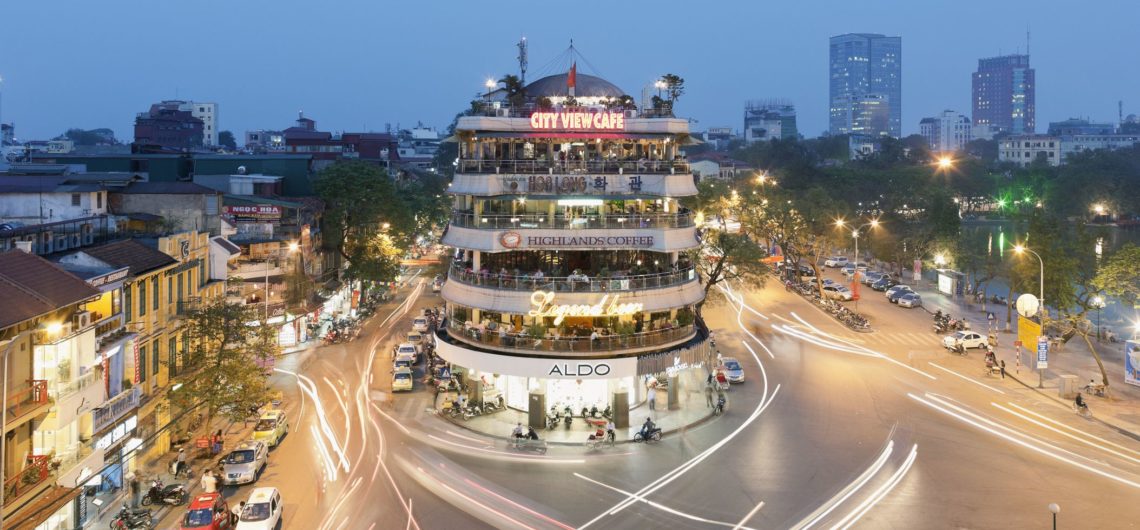
Comments